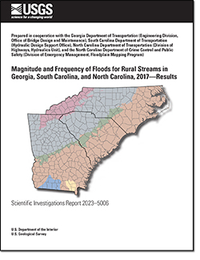Magnitude and Frequency of Floods for Rural Streams in Georgia, South Carolina, and North Carolina, 2017—Results
Links
- Document: Report (12.1 MB pdf) , HTML , XML
- Related Work: Fact Sheet 2023–3011 - Magnitude and frequency of floods for rural streams in Georgia, South Carolina, and North Carolina, 2017--Summary
- Data Releases:
- USGS data release - Magnitude and frequency of floods for rural streams in Georgia, South Carolina, and North Carolina, 2017—Data
- USGS data release - Model archive for magnitude and frequency of floods for rural streams in Georgia, South Carolina, and North Carolina, 2017
- Download citation as: RIS | Dublin Core
Abstract
Reliable estimates of the magnitude and frequency of floods are an important part of the framework for hydraulic-structure design and flood-plain management in Georgia, South Carolina, and North Carolina. Annual peak flows measured at U.S. Geological Survey streamgages are used to compute flood‑frequency estimates at those streamgages. However, flood‑frequency estimates also are needed at ungaged stream locations. A process known as regionalization was used to develop regression equations to estimate the magnitude and frequency of floods at ungaged locations.
A multistate approach was used to update estimates of the magnitude and frequency of floods in rural, ungaged basins in Georgia, South Carolina, and North Carolina. Annual peak-flow data through September 2017 were analyzed for 965 streamgages with 10 or more years of data on rural streams in Georgia, South Carolina, North Carolina, and adjacent parts of Alabama, Florida, Tennessee, and Virginia. Flood‑frequency estimates of the 50‑, 20‑, 10‑, 4‑, 2‑, 1‑, 0.5‑, and 0.2‑percent annual exceedance probability streamflows, which correspond to flood-recurrence intervals of 2, 5, 10, 25, 50, 100, 200, and 500 years, respectively, were computed for the 965 streamgages following national guidelines. As part of the computation of flood‑frequency estimates for the streamgages, an updated value for the regional skew coefficient (0.048) was developed using a Bayesian generalized least squares regression model. The new regional skew has a mean square error or average variance of prediction of 0.092. Additionally, basin characteristics for these stations were computed using a geographical information system.
Exploratory analyses on the 965 streamgages confirmed the five hydrologic regions for Georgia, South Carolina, and North Carolina defined in a previous rural flood‑frequency study. From the 965 streamgages, streamgages with 30 or more years of record were used to complete a peak-flow trend analysis. Of the 965 streamgages, 164 streamgages were found to be redundant and were excluded from the regional regression analyses. Data from the remaining 801 streamgages (292 in Georgia, 75 in South Carolina, 303 in North Carolina, 15 in Alabama, 12 in Florida, 39 in Tennessee, and 65 in Virginia) were used in a regional regression analysis relating basin characteristics to flood‑frequency estimates. This analysis, based on generalized least squares regression, was used to develop a set of predictive equations to estimate the 50‑, 20‑, 10‑, 4‑, 2‑, 1‑, 0.5‑, and 0.2‑percent annual exceedance probability streamflows for rural, ungaged basins in Georgia, South Carolina, and North Carolina. The final set of predictive equations are all functions of drainage area and percentage of the drainage basin within each of the five hydrologic regions. Average errors of prediction for these regression equations range from 35.8 to 44.4 percent.
Flood‑frequency estimates also were computed for 72 regulated (for example, a streamgage where flow is altered by a dam or weir) streamgages in Georgia, South Carolina, and North Carolina with 20 or more years of post-regulation record using data through water year 2019. The water year is the annual period from October 1 through September 30 and is designated by the year in which the period ends. Of the 72 regulated streamgages, 18 had pre-regulated periods of record that also were analyzed as part of this study. Flow adjustments were applied to historic peaks and large floods from the pre-regulated period, if available, for use in the post-regulation frequency analysis. Estimates of large floods provide valuable information in frequency analysis and, thus, were included in the post-regulation frequency analysis.
Suggested Citation
Feaster, T.D., Gotvald, A.J., Musser, J.W., Weaver, J.C., Kolb, K.R., Veilleux, A.G., and Wagner, D.M., 2023, Magnitude and frequency of floods for rural streams in Georgia, South Carolina, and North Carolina, 2017—Results: U.S. Geological Survey Scientific Investigations Report 2023–5006, 75 p., https://doi.org/10.3133/sir20235006.
ISSN: 2328-0328 (online)
Study Area
Table of Contents
- Acknowledgments
- Abstract
- Introduction
- Data Compilation
- Estimation of Flood Magnitude and Frequency at Streamgages
- Comparison of Selected Flood-Frequency Estimates with the Previous Estimates
- Streamgages Affected by Regulation
- Estimation of Flood Magnitude and Frequency at Ungaged Sites
- Application of Flood-Frequency Methods
- StreamStats
- Summary and Conclusions
- References Cited
- Appendix 1. Regional Skew Regression Analysis for Georgia, South Carolina, and North Carolina
| Publication type | Report |
|---|---|
| Publication Subtype | USGS Numbered Series |
| Title | Magnitude and frequency of floods for rural streams in Georgia, South Carolina, and North Carolina, 2017—Results |
| Series title | Scientific Investigations Report |
| Series number | 2023-5006 |
| DOI | 10.3133/sir20235006 |
| Publication Date | April 28, 2023 |
| Year Published | 2023 |
| Language | English |
| Publisher | U.S. Geological Survey |
| Publisher location | Reston, VA |
| Contributing office(s) | Georgia Water Science Center, South Atlantic Water Science Center |
| Description | Report: ix, 75 p.; 2 Data Releases |
| Country | United States |
| State | Georgia, North Carolina, South Carolina |
| Online Only (Y/N) | Y |
| Additional Online Files (Y/N) | N |


